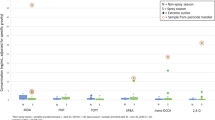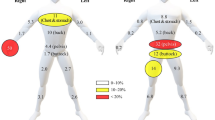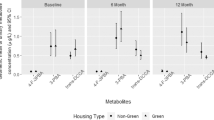Abstract
Although direct contact during mixing/loading, application or repair and clean-up is the major pathway by which individuals living on farms are exposed to herbicides, indirect sources such as contact with contaminated surfaces may also contribute. As part of a biomonitoring study to measure the nature and extent of exposure of farm families to herbicides, we attempted to identify potential indirect sources of exposure in a subset of 32 Ontario farms. Herbicide residues in drinking water samples as well as surface swipes of common surfaces within the home were measured and compared with urinary concentrations of the applicator, spouse and child. Residues of 2,4-dichlorophenoxyacetic acid (2,4-D) were measured on all surfaces that were tested, with the highest levels found on the washing machine knob and wash-up faucet within the home. Drinking water was not a significant source of exposure to 2,4-D for farm families. Urine samples of family members were weakly correlated with residues of 2,4-D measured on the exterior door knob. The applicators in our study, the most highly exposed subpopulation in our study group, had exposures that were less than one-third of the exposure on a daily, lifetime basis deemed to be safe by regulatory agencies in Canada and the United States. As 2,4-D residues were detected on surfaces in farm homes where 2,4-D was not reportedly used at that time, this suggests that 2,4-D applied during a previous season (or on a neighbouring farm) may be tracked into the home and persist on hard surfaces and be a chronic, albeit low level, source of exposure for family members. Pesticide applicators and their families should be counselled on hygienic practices (e.g. removing footware and washing soiled hands prior to entering the home) to reduce indirect sources of exposure.
This is a preview of subscription content, access via your institution
Access options
Subscribe to this journal
Receive 6 print issues and online access
$259.00 per year
only $43.17 per issue
Buy this article
- Purchase on Springer Link
- Instant access to full article PDF
Prices may be subject to local taxes which are calculated during checkout

Similar content being viewed by others
References
Arbuckle T.E., Burnett R., Cole D., Teschke K., Dosemeci M., Bancej C., and Zhang J. Predictors of herbicide exposure in farm applicators. Int Arch Occup Environ Health 2002: 75: 406–414.
Arbuckle T.E., Cole D.C., Ritter L., and Ripley B.D. Farm children's exposure to herbicides: comparison of exposure estimates derived from biomonitoring and questionnaire data. Epidemiology 2004: 15: 187–194.
Arbuckle T.E., Schrader S.M., Cole D., Hall J.C., Bancej C.M., Turner L.A., and Claman P. 2,4-Dichlorophenoxyacetic acid residues in semen of Ontario farmers. Reprod Toxicol 1999a: 13: 421–429.
Arbuckle T.E., Savitz D.A., Mery L.S., and Curtis K.M. Exposure to phenoxy herbicides and the risk of spontaneous abortion. Epidemiology 1999b: 10: 1–9.
Blair A., and Zahm S.H. Pesticides and cancer: status and priorities. In: Bertollini R., Lebowitz M.D., Saracci R., and Savitz D. (Eds.). Environmental Epidemiology: Exposure and Disease. CRC Lewis Publishers, Boca Raton, FL, 1996, pp. 83–97.
Boeniger M.F., Lowry L.K., and Rosenberg J. Interpretation of urine results used to assess chemical exposure with emphasis on creatinine adjustments: a review. Am Ind Hyg Assoc J 1993: 54: 615–627.
Bruce D., Direct and indirect exposure to the farm family to chlorophenoxyacetic acid herbicides. M.Sc. thesis, University of Guelph, Guelph, ON, Canada, 1999.
Buckley T.J., Liddle J., Ashley D.L., Paschal D.C., Burse V.W., Needham L.L., and Akland G. Environmental and biomarker measurements in nine homes in the Lower Rio Grande Valley: multimedia results for pesticides, metals, PAHs, and VOCs. Environ Int 1997: 23: 705–732.
Curtis K.M., Savitz D.A., Weinberg C.R., and Arbuckle T.E. The effect of pesticide exposure on time to pregnancy. Epidemiology 1999: 10: 112–117.
Feldman R.J., and Maibach H.I. Percutaneous penetration of some pesticides and herbicides in man. Toxicol Appl Pharmacol 1974: 28: 126–132.
Fitzgerald D., Chanasyk D.S., Neilson R.D., Kiely D., and Audette R. Farm well water quality in Alberta. Water Qual Res J Can 2001: 36: 565–588.
Fleeker J. Two enzyme immunoassays to screen for 2,4-dichlorophenoxyacetic acid in water. J Assoc Offic Anal Chem 1987: 70: 874–878.
Hall J.C., Deschamps R.J.A., and Krieg K.K. Immunoassays for the detection of 2,4-D and picloram in river water. J Agric Food Chem 1989: 37: 981–984.
Harris S.A., Purdham J.T., Corey P.N., and Sas-Kortsak A.M. An evaluation of 24-hour urinary creatinine excretion for use in identification of incomplete urine collections and adjustment of absorbed dose of pesticides. Am Ind Hyg Assoc J 2000: 61: 649–657.
Harris S.A., and Solomon K.R. Percutaneous penetration of 2,4-dichlorophenoxyacetic acid and 2,4-D-dimethylamine salt in human volunteers. J Toxicol Environ Health 1992: 36: 233–240.
Hill B.D., Harker K.N., Hasselback P., Inaba D.J., Byers S.D., and Moyer J.R. Herbicides in Alberta rainfall as affected by location, use and season: 1999–2000. Water Qual Res J Can 2002: 37: 515–542.
Lewis R.G., Fortmann R.C., and Camann D.E. Evaluation of methods for monitoring the potential exposure of small children to pesticides in the residential environment. Arch Environ Contam Toxicol 1994: 26: 37–46.
Melnyk L.J., Berry M.R., and Sheldon L.S. Dietary exposure from pesticide application on farms in the agricultural health pilot study. J Exposure Anal Environ Epidemiol 1997: 7: 61–80.
Nishioka M., Hines C., Brinkman M., Burkholder H., and Lewis R.G. Comparison of commercial vs homeowner application for transport of lawn-applied herbicide 2,4-D into homes. US Environmental Protection Agency report EPA/600/A-97/075, 1997.
Nishioka MG, Burkholder HM, Brinkman MC, and Hines C. Transport of lawn-applied 2,4-D from turf to home: assessing the relative importance of transport mechanisms and exposure pathways. National Exposure Research Laboratory, US Environmental Protection Agency, Research Triangle Park, NC, March 1999. PB99-156358. 1999.
Nishioka M.G., Lewis R.G., Brinkman M.C., Burkholder H.M., Hines C.E., and Menkedick J.R. Distribution of 2,4-D in air and on surfaces inside residences after lawn applications: comparing exposure estimates from various media for young children. Environ Health Perspect 2001: 109: 1185–1191.
O'Rourke M.K., Lizardi P.S., Rogan S.P., Freeman N.C., Aguirre A., and Saint C.G. Pesticide exposure and creatinine variation among young children. J Exposure Anal Environ Epidemiol 2000: 10: 672–681.
Ripley B.D., Leishman P., Stasiuk R., Jaworski T., and Burchat C.S. Pesticide exposure assessment study — pesticides in well water part 1: analytical results and methodology. Pesticide and Trace Contaminants Laboratory, Agricultural and Food Laboratory Services Branch, Ontario Ministry of Agriculture, Food and Rural Affairs, Guelph, Ontario. December 1996.
SAS Institute. SAS/STAT User's Guide, Version 7-1, SAS Institute Inc., Cary, NC, 1999.
Savitz D.A., Arbuckle T., Kaczor D., and Curtis K.M. Male pesticide exposure and pregnancy outcome. Am J Epidemiol 1997: 146: 1025–1036.
US EPA. Report of the Hazard Identification Assessment Review Committee. TXR NO. 0051866, May, 2003.
Wilson N.K., Chuang J.C., Lyu C., Menton R., and Morgan M.K. Aggregate exposures of nine preschool children to persistent organic pollutants at day care and at home. J Exposure Anal Environ Epidemiol 2003: 13: 187–202.
Wilson N.K., Chuang J.C., and Lyu C. Levels of persistent organic pollutants in several child day care centers. J Exposure Anal Environ Epidemiol 2001: 11: 449–458.
Acknowledgements
We thank the Expert Working Group and Consultative Committee for their input to the design of the study, Jocelyn Rouleau, Christina Bancej and Jun Zhang for their work on data management and editing and the Ontario farm families who participated. Analysis of drinking water samples for pesticide residues was conducted by Brian Ripley and his team at the Ontario Ministry of Agriculture, Food and Rural Affairs. This research was funded by Health Canada. This work does not necessarily reflect the views of Health Canada and no official endorsement should be inferred.
Author information
Authors and Affiliations
Corresponding author
Rights and permissions
About this article
Cite this article
Arbuckle, T., Bruce, D., Ritter, L. et al. Indirect sources of herbicide exposure for families on Ontario farms. J Expo Sci Environ Epidemiol 16, 98–104 (2006). https://doi.org/10.1038/sj.jea.7500441
Received:
Accepted:
Published:
Issue Date:
DOI: https://doi.org/10.1038/sj.jea.7500441
Keywords
This article is cited by
-
An algorithm for quantitatively estimating non-occupational pesticide exposure intensity for spouses in the Agricultural Health Study
Journal of Exposure Science & Environmental Epidemiology (2019)
-
Multiresidue determination of chlorophenoxy acid herbicides in human urine samples by use of solid-phase extraction and capillary LC–UV detection
Analytical and Bioanalytical Chemistry (2008)



